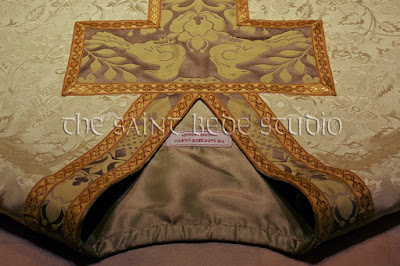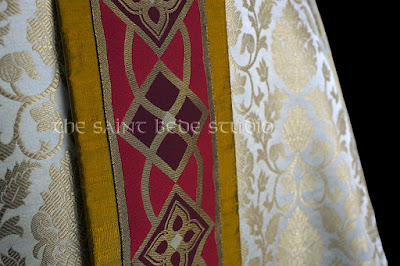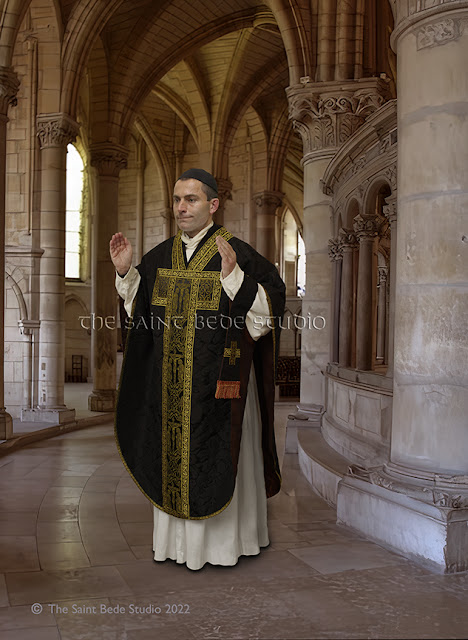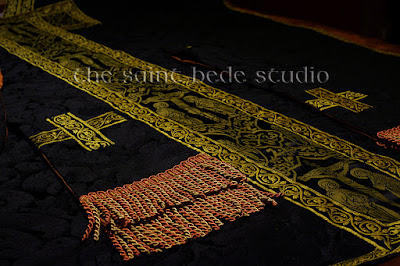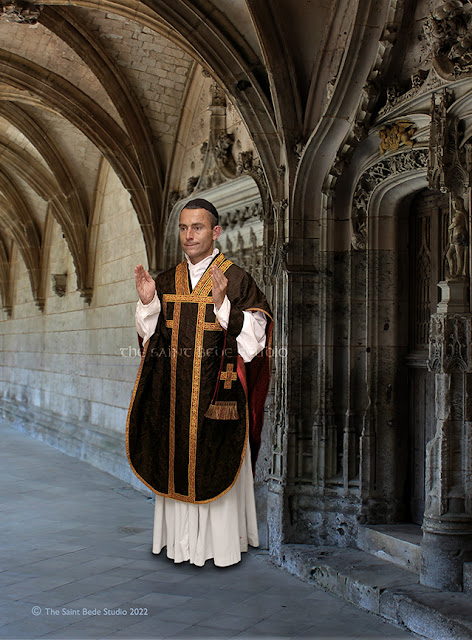 |
Figure 1.
The celebration of Mass "ad orientem" according to
the New Missal in a French Monastic Community. |
Almost twenty years ago, a priest of the Toronto Oratory published a book titled The Mass and Modernity : Walking to Heaven Backward. It is an excellent philosophical study and profound in its discussion of the difficulties facing the Church because of the collapse of her Liturgical praxis. EN1 The author, Father Robinson, was inspired by a celebrated phrase in one of the Sermons of Saint JH Newman on the path we take to salvation. Father Robinson observes that Saint Newman was writing about the individual who learns the truth about faith and right conduct through the experience of error :
He [Newman] was reminding us that, in fact, we all make mistakes about the meaning of life and how it should be lived. But things do not stop there because we then go on to act out these mistaken ideas, and this is true even if or when we are not very clear as to what exactly the ideas are. Bad practice is based on confused and false principles, and it is by an often bitter experience that we finally see the truth a bit more clearly and so find ourselves a little nearer to the Promised Land. EN2
Father Robinson suggests that this metaphor of the path to salvation is most applicable to the intense debates about the Church's Liturgy over almost 60 years. It would be fair to conclude that these debates (some have termed them "wars") are but one manifestation of the increasingly polarised state of the Church. In this little essay, we cannot plumb the philosophical depths of the arguments held by each side, nevertheless observing that these philosophical differences are the substance of the disagreement. It would be regrettable to describe this debate as political, even though it manifests itself politically and in externals.
The current phase of these debates presents irreconcilable differences - each side deems the other to be in an indefensible situation and harming the good of the Church. This is debated continuously and often heatedly, on the wide-world of the Web. The subject matter is so familiar to readers, that it is unnecessary to mention the small details, but merely to make some observations.
OPPOSING POSITIONS
There are two opposing positions (with many variations) in this particular battle of the Liturgy Wars.
The first position is a rejection of the notion that the Roman Rite has two forms, Ordinary and Extraordinary, since this is deemed to be contrary to the decisions of the Second Vatican Council. EN3 The notion is to be corrected by the suppression of that form which preceded the Council (the Extraordinary Form of the Roman Rite), regardless of the confusion or scandal that might be caused in the process.
The opposing position is that the Rites which were promulgated after the conclusion of the Council (the Ordinary Form of the Roman Rite) were an illegitimate and fraudulent exercise in ecclesiastical authority, which cast aside Tradition for misguided ideological ends; the remedy, therefore, is that those revised Rites be suppressed, regardless of the practical difficulty of doing so.
There are loud voices making clear these two positions, but not everyone who takes an interest in these matters holds to one or the other of the two positions. Many are disturbed by the intensity in which these two positions are debated.
The Catholic World is not divided into Defenders of Liturgical Tradition and its Opponents. There are many debates in the Church and perhaps they are underpinned by the same divergent philosophies. Defenders of a strict liturgical Tradition are not numerous in the sum of the Church's Faithful and they seem mainly to be voices of the Western World. The Churches of Africa, Asia and South America do not seem to be deeply involved in these liturgical debates and are largely content with the revised Rites which emerged after 1969. We might be mindful that the Faithful in these continents comprise a large number of the world's Catholics.
BUILDING UP THE SACRED
In his instruction Desiderio desideravi, the present Bishop of Rome wished to encourage a culture where the Sacred Liturgy is celebrated with sacrality and due decorum and that the Faithful be well-formed in what takes places when they gather to celebrate the Rites of the Church. This is an admirable aspiration, which aligns with the teachings of the Second Vatican Council on the Sacred Liturgy and, indeed, the teachings of previous Popes. But, unfortunately, the same vigour with which the Holy See acts to restrict the celebration of the former Missal is not also applied to the much more numerous and widespread abuses - worldwide - in the manner of celebrating the Revised Rites. The failure to act against these abuses - some of them sacrilegious - undermines what the Bishop of Rome claims he has "desired with a great longing".
Also detracting from claims made in Traditionis Custodes and Desiderio desideravi is a vast body of reputable scholarship discussing the development of the Revised Rites and the ideology underpinning those revisions. It is no longer credible simply to assert that the New Order of Mass is the "unique" expression of the Roman Rite, nor to claim that it is completely consonant with the Tradition of the Church's liturgical prayer and ritual gestures. It is well that these objections be understood and not be dismissed out of hand as the ravings of agitators and arch-conservatives.
It must also be remembered, on the other hand, that for the majority of Catholics, such scholarship is not relevant to their faith-lives. The majority of Catholics are content with the state of the Church's Liturgy as they experience it each week. Some, however, are more disposed to a re-sacralisation of the Rites than others. Priests who celebrate both forms of the Roman Rite may not have the luxury to choose one to the exclusion of the other, nor think it desirable.
MAKING THE SAME MISTAKES
Those who are convinced that the Church is going to abandon the Revised Rites in favour of a more strict liturgical Tradition are going to be disappointed. And those who believe that they can stifle the aspirations of Faithful Catholics with authoritarian acts of ritual repression will also be disappointed. When insufficient magnanimity underpins both positions, neither can expect or deserve success.
It is justly pointed out that the perilous speed in which the revision of the Church's principal rites was carried out in the period 1965 - 1969 was harmful to the Church. Pope Benedict, in criticising the Revisions, noted a mentality which produced a "banal product of the moment". EN4 These insightful words have been conveniently ignored.
In the fifty or so years since, there have been too many changes in the Liturgy for the Faithful adequately to accommodate. A liturgical spirituality cannot be formed in a milieu of ongoing adaptations and the frequent introduction of new music and liturgical texts. In the West, the results of this are all-too evident. Why then, would the solution be to introduce another raft of changes, aimed at reversing those revisions? Why would that be any more prudent and less disruptive?
FEWER DOCUMENTS AND MORE REAL DIALOGUE
A stalemate is not quite the end of the matter, however, nor is that a Christian manner of resolving disagreements. We might hope for (but not expect soon), dialogue, rather than pronouncements from on high, whilst noting that this issue will not figure at all in the opaque discussions of the much-vaunted Synod on Synodality. At this moment, Authority is interested in only certain debates.
Everyone who takes the view that a "Reform of the Reform" is needed, has his or her own ideas on what form that should take. Might it not be best, however, that the future of liturgical reform be taken slowly, carefully and with greater charity on all sides? Those agitating for complete suppression of the Revised Rites might take a step backwards to reflect on wider realities within the Church. Similarly, the Holy See should allow the more ancient Rites of the Church to be celebrated without paranoid restrictions and cease the unpastoral ostracisation and misrepresentation of its adherents. The sanctification of the Church through its Sacred Liturgy is not well-served by ideological attempts to deny realities, even with the noble motives and aspirations. We should hope and pray for a ceasefire in these Liturgy Wars.
Over a passage of years - not even the blink of an eye in God's time - it will become obvious, more acceptable, that aspects of the Revised Rites are a product of an era which is gone and no longer enriching to the Church, or providing what is needed to draw souls to Christ. And those who have defended (should we write "imposed"?) those Revisions so emphatically will also be gone. A reform of the Roman Rite is necessary and desirable, but can only be attempted at a moment free from rancour. The process of Reform should not be limited to discussions between liturgical scholars, nor should the experiences of the last sixty years - good and bad - simply be set aside, as if they never took place. Learning from collective mistakes and setting aside imperfect premises, such a reform might be undertaken carefully, rooted in Tradition, but with pastoral sensitivity, one cautious step at a time, and backward.
We advance to the truth by experience of error; we succeed through failures. We know not how to do right except by having done wrong. We call virtue a mean, that is, as considering it to lie between things that are wrong. We know what is right, not positively, but negatively; we do not see the truth at once and make towards it, but we fall upon and try error, and find it is not the truth. We grope about by touch, not by sight, and so by a miserable experience exhaust the possible modes of acting till naught is left, but truth, remaining. Such is the process by which we succeed; we walk to Heaven backward.
Saint J.H. Newman "Parochial and Plain Sermons" Vol. 5, no. 8.
 |
| Figure 2. A scene at the Second Vatican Council. |
END-NOTES
EN1 Robinson, Jonathon, The Mass and Modernity : Walking to Heaven Backward, Ignatius Press, San Francisco 2005.
EN2 Robinson, op.cit., page 344.
EN3 The terms Ordinary and Extraordinary as applied to the Mass of the Roman Rite originated in 2007 with Pope Benedict's motu proprio Summorum Pontificum. In this essay, we will refer to the Ordinary form as The Revised Rites since we are also discussing the revised liturgical books of the Sacraments, Episcopal ceremonies &c.
EN4 The following article is an investigation of the words written by the then Cardinal Ratzinger : https://sharonkabel.com/post/ratzinger-fabricated-liturgy/
AMDG









